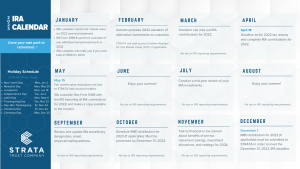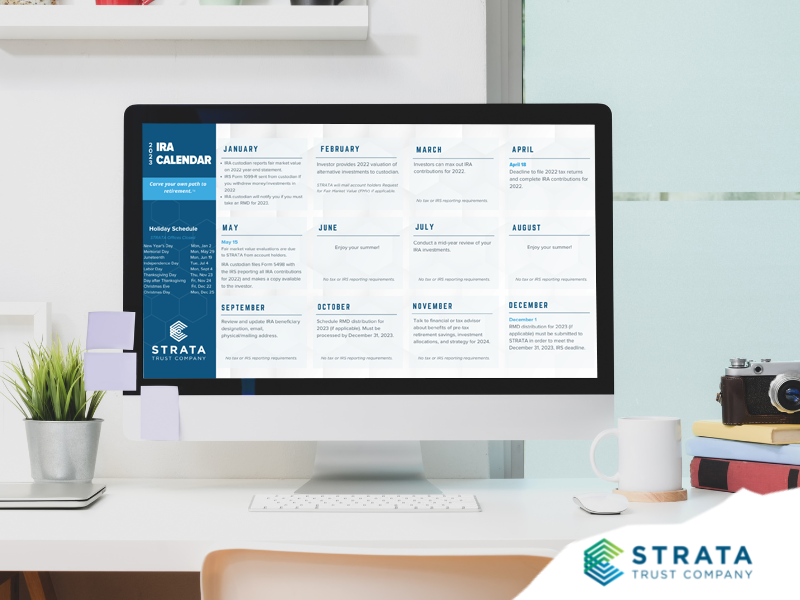Looking for a New Year’s resolution that will benefit your retirement portfolio? STRATA’s 2023 IRA Calendar can help you commit to achieving one goal or task for your self-directed IRA each month. Some months you must take steps to maintain the tax-qualified status of your IRA, while in other months you can manage administrative and planning tasks to make sure you’re achieving your savings and investment targets. Organizing tasks throughout the year can help you meet your IRA deadlines and responsibilities efficiently and effectively. Make sure you subscribe to our Insights Blog for timely informative articles on investing and maintaining your self-directed IRA.

Download STRATA’s 2023 IRA Calendar
January
![]()
Watch for important documents from your IRA custodian in January. Review them to make certain they are accurate; they will affect your tax liability for 2022 or future years. By January 31, you should receive the following information, which may be provided in one or more deliveries:
- Fair Market Value Statement – Your IRA custodian must report the value of your IRA as of the prior December 31. If your IRA holds alternative investments that don’t have a readily attainable fair market value, you must provide a valuation to your IRA custodian each year before the custodian must file fair market value information with the IRS.
- RMD Notice – If you will be age 73 or older in 2023, your IRA custodian will inform you of the requirement to take a minimum distribution (RMD) in 2023. (Before 2023, the beginning age for RMDs was 72. The SECURE 2.0 Act of 2022 increased the RMD age to 73 for IRA owners who did not reach age 72 by December 31, 2022.)
- IRS Form 1099-R – If you withdrew money or investments from your IRA in 2022, your IRA custodian will send you a copy of IRS Form 1099-R to report the value of the distribution and any federal or state tax withheld and remitted. This form is also filed with the IRS to report taxable income you received in 2022 and any tax withholding remitted on your behalf. Form 1099-R does not reflect certain activity that could reduce your tax liability for a distribution, such as completing a rollover or taking a distribution that includes nondeductible contributions (basis). You must notify the IRS on your tax return that you qualify for reduced tax liability as a result of any of these situations.
Think about setting up a series of direct deposits to fund your self-directed IRA throughout the year. Splitting up the 2023 contribution amount of $6,500 ($7,500 if you’re age 50 or older) into monthly or quarterly deposits into your IRA can make saving easier compared to a lump sum deposit at the end of the year.
February

A valuation of your alternative investments as of December 31, 2022, must be provided to your IRA custodian each year. Depending on the type of investments in your IRA, the investment issuer may provide a valuation to STRATA for you, or you may need to arrange to have your investments valued by a qualified appraiser. STRATA will mail a request for fair market value to remind you.
March

Contribute the maximum amount to your IRA for 2022. You still have time to contribute and take a deduction on your tax return for 2022. You can contribute up to $6,000 (or 100% of your income if less) to your Traditional and Roth IRAs ($7,000 if you’re age 50 or older) until April 18, 2023, as a contribution for 2022. Be sure to include instructions with your deposit if you want your IRA custodian to treat the contribution for 2022, or they will treat it as a 2023 contribution.
April

Take your 2022 RMD by April 1 if you turned 72 in 2022 and waited until 2023 to take your first RMD.
File your 2022 individual income tax return by April 18, 2023. April 15 is the usual deadline, but it falls on a weekend in 2023, and the next business day falls on a holiday, so Tax Day is the next business day, April 18. All individual filers may apply for an extension to file by October 17. Be sure to include Form 8606, Nondeductible IRAs, with your tax return to track nontaxable assets in your IRAs.
May

Submit your fair market value evaluations to STRATA by May 15 for your IRA alternative investments.
Watch for your copy of IRS Form 5498, IRA Contribution Information, from your IRA custodian by May 31. This form reports all contributions made to your IRA for 2022, including annual contributions, rollovers, conversions, and recharacterizations. Form 5498 must also include the fair market value of your entire IRA and separately report the value of certain hard-to-value investments in your IRA. This information is filed with the IRS, so it’s important to provide accurate valuations to your IRA custodian and make sure your tax return contains information that matches Form 5498.
June – July – August

Conduct a mid-year review of your IRA investments this summer while there are no tax or IRS requirements to perform. Half-way into 2023 – are your investments performing as you expected? Do you need to adjust your objectives to reduce risk or to address the current economy or market conditions? A self-directed IRA provides the freedom to invest your IRA in a wide array of alternative investments, such as real estate and private equities, that offer diversification from more traditional investments tied to the stock market; you may want to visit with your financial advisor this summer to explore a wider range of investment alternatives.
September

Revisit your beneficiary designation for your IRAs. Have you married, divorced, and/or had a child this year? Have you opened a new IRA or transferred assets between IRAs? Any of these types of actions may trigger a need to change your IRA beneficiaries. If not, at least confirm that your beneficiaries’ addresses, telephone numbers, and email information are correct, so that legal rights to your IRA assets will be transferred smoothly to the beneficiary of your choice upon your death—outside of probate.
October

If you filed your 2022 taxes timely, October 17 is the deadline to correct an excess contribution for 2022 and to recharacterize a 2022 contribution from a Traditional IRA to a Roth IRA or vice versa.
Schedule your 2023 RMD so it is processed by December 31. (If you are turning 73 in 2023, you may wait until April 1, 2024, to take your 2023 RMD.) The amount you are required to take will be based on your December 31, 2022, IRA balance and the IRS’s life expectancy tables. If your IRA investments must be liquidated to payout the RMD, consider whether you want to take an in-kind distribution of your investment instead, or if you can satisfy your RMD from another IRA with more liquid assets.
November

If your taxable income for the year is less than you anticipated or well below the next tax bracket, you may want to consider converting some of your Traditional, SEP, or SIMPLE IRA assets to a Roth IRA. This is a taxable transaction, so it could increase your tax liability for 2023. But Roth IRAs are not subject to the RMD requirements while you’re alive, and all Roth IRA distributions can be tax-free. If you’re interested in creating a tax-free income stream in retirement or for your heirs, talk to your financial or tax advisor about the benefits and considerations of converting pre-tax retirement assets to an after-tax Roth IRA.
December

Take your RMD, if you are 73 or older, before December 31. If you are a beneficiary of an IRA, you may need to elect a payment option or take a payment from an inherited IRA by December 31. If an IRA owner or beneficiary fails to take a required payment for 2022, they are subject to a 50% excise tax on the portion of the amount that should have been distributed but remained in the IRA. For tax year 2023 and future years, the excise tax is reduced to 25% of a missed payment, which can be reduced to 10% if the payment is taken within a two-year correction window.
December 31 is also the deadline to complete a conversion to a Roth IRA if you want the additional income counted for the 2023 tax year.
Talk to your financial or tax advisor before the end of the year if any of these situations apply to you … and start planning for 2024!
For More Information
If you have any questions about your IRA or the IRS requirements for IRAs, contact our self-directed IRA experts. Additionally, our Knowledge Center is filled with informative articles covering all aspects of IRAs.
















